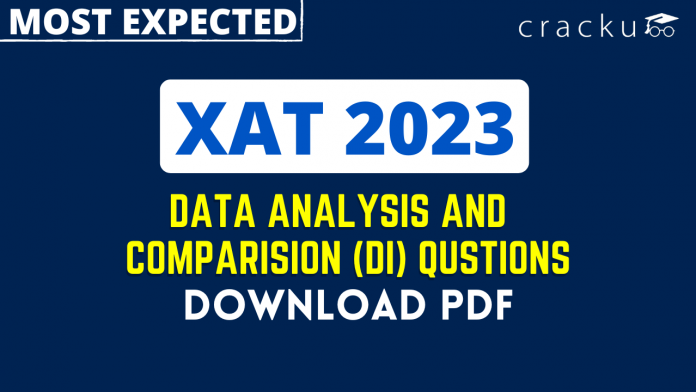Data Analysis and Comparision (DI) Questions for XAT
Download Data Analysis and Comparision Questions for XAT PDF – XAT Data Analysis and Comparision questions pdf by Cracku. Practice XAT solved Data Analysis and Comparision Questions paper tests and These sample questions are to analyse the XAT exam pattern. Top 15 very Important Data Analysis and Comparision Questions for XAT based on asked questions in previous exam papers. The XAT question papers contain actual questions asked with answers, solutions.
Download Data Analysis and Comparision (DI) Questions for XAT
Enroll to XAT 2023 Crash Course
Instructions
Read the following graph carefully and answer questions given below it.
Production of three Different Types of Tyres by a Company over the Years (in lakhs)

Question 1: The total production of C type tyre in 1992 and 1993 together was what percentage of Production of B type tyres in 1994?
a) 50
b) 100
c) 150
d) 200
e) None of these
1) Answer (E)
Solution:
Total production of C type tyre in 1992 and 1993 together (in lakhs) = 30 + 25 = 55
Production of B type tyres in 1994 (in lakhs) = 32.5
=> Required % = $\frac{55}{32.5} \times 100$
$\approx 170 \%$
Thus, answer is none of these.
Question 2: In which of the following years was percentage production of B type tyres to C type tyres the maximum?
a) 1994
b) 1992
c) 1996
d) 1993
e) 1995
2) Answer (E)
Solution:
Percentage production of B type tyres to C type tyres = Ratio of B type tyres to C type tyres in :
1992 = $\frac{20}{30}$ = 0.67
1993 = $\frac{30}{25}$ = 1.2
1994 = $\frac{32}{22.5}$ = 1.4
1995 = $\frac{37.5}{22.5}$ = 1.67 [MAX]
1996 = $\frac{15}{32.5}$ = 0.4
=> Ans – (E)
Question 3: The total number of all the three tyres manufactured was the least in which of the following years?
a) 1995
b) 1996
c) 1992
d) 1994
e) 1993
3) Answer (B)
Solution:
Total number of all the three tyres manufactured in (in lakhs) :
1992 : 25 + 20 + 30 = 75
1993 : 20 + 30 + 25 = 75
1994 : 32.5 + 32.5 + 22.5 = 87.5
1995 : 27.5 + 37.5 + 22.5 = 87.5
1996 : 15 + 15 + 32.5 = 62.5 [MIN]
=> Ans – (B)
Question 4: What was the difference between the number of B type tyres manufactured in 1994 and 1995?
a) 5,00,000
b) 20,00,000
c) 10,00,000
d) 15,00,000
e) None of these
4) Answer (A)
Solution:
Number of B type tyres manufactured in 1994 = 32.5 lakhs
Number of B type tyres manufactured in 1995 = 37.5 lakhs
=> Required difference = (37.5 – 32.5) lakhs = 5,00,000
=> Ans – (A)
Question 5: What was the percentage drop in the number of C type tyres manufactured from 1993 to 1994?
a) 25
b) 10
c) 15
d) 2.5
e) None of these
5) Answer (B)
Solution:
Number of C type tyres manufactured in 1993 (in lakhs) = 25
Number of C type tyres manufactured in 1994 (in lakhs) = 22.5
=> Required % drop = $\frac{(25 – 22.5)}{25} \times 100$
= $2.5 \times 4 = 10 \%$
=> Ans – (B)
Instructions
Read the following Table and answer the given questions



Question 6: In which of the following periodicals ,the student P obtained highest percentage of the marks?
a) I
b) II
c) III
d) IV
e) V
6) Answer (E)
Solution:
Total marks obtained by student P :
I = 40 + 30 + 35 + 45 + 24 = 174
II = 30 + 40 + 25 + 47 + 28 = 170
III = 45 + 25 + 15 + 32 + 36 = 153
IV = 20 + 30 + 30 + 39 + 39 = 158
V = 35 + 20 + 40 + 37 + 43 = 175 [MAXIMUM]
=> Ans – (E)
Question 7: In which of the following subjects was the average percentage of marks obtained by student S the highest?
a) Maths
b) Science
c) History
d) Geography
e) English
7) Answer (C)
Solution:
Total marks obtained by student S in subject :
Maths = 25 + 35 + 40 + 45 + 30 = 175
Science = 31 + 34 + 38 + 27 + 30 = 160
History = 34 + 40 + 36 + 42 + 48 = 200 [MAXIMUM]
Geography = 39 + 37 + 44 + 40 + 30 = 190
English = 31 + 34 + 35 + 45 + 40 = 185
=> Ans – (C)
Question 8: The average percentage of marks obtained by student P in Maths in five periodicals was exactly equal to the average percentage of marks obtained by Student R in the five periodicals in which of the following subjects ?
a) English
b) Geography
c) Science and Geography
d) Maths
e) None of these
8) Answer (B)
Solution:
Total marks obtained by student P in Maths = 40 + 30 + 45 + 20 + 35 = 170
=> Average marks of P in Maths = $\frac{170}{5} = 34$
Marks scored by student R in subject :
Maths = 30 + 36 + 40 + 45 + 40 = 191
Science = 48 + 46 + 31 + 40 + 80 = 245
History = 35 + 45 + 40 + 30 + 35 = 185
Geography = 25 + 35 + 48 + 37 + 25 = 170
=> Average marks of R in Geography = $\frac{170}{5}=34$
=> Ans – (B)
Question 9: what was the total marks of the student’s T in the science in all the periodicals together?
a) 160
b) 180
c) 190
d) 140
e) None of these
9) Answer (C)
Solution:
Total marks of the student’s T in the science in all the periodicals together
= 44 + 36 + 40 + 30 + 40
= 190
=> Ans – (C)
Question 10: What was the average marks of five Subjects of Q in the periodical I ?
a) 32
b) 34
c) 40
d) 30
e) None of these
10) Answer (A)
Solution:
Total marks of five Subjects of Q in the periodical I
= 30 + 25 + 33 + 42 + 30 = 160
=> Required average = $\frac{160}{5}=32$
=> Ans – (A)
Instructions
Study the following graph carefully and answer the questions given below it.
Net Profit Percentage of the two Companies over the years?

Question 11: In which of the following years was the total income more than double the total expenditure in that year for Company B?
a) 1995
b) 1993
c) 1996
d) 1992
e) None of these
11) Answer (E)
Solution:
For income to be more than double the total expenditure, the profit % = $\frac{2I – I}{I} \times 100$ = $100 \%$
=> Profit % must be more than 100%
But, as clearly seen from the line graph, for company B, the profit percent is not more than 100% for any year
=> Ans – (E)
Question 12: If the total expenditure of company B in 1994 was Rs.200 crore ,what was the total income ?
a) 160 crores
b) 240 crores
c) 260 crore
d) Data Inadequate
e) None of these
12) Answer (E)
Solution:
Total expenditure of company B in 1994 = Rs.200 crore
Profit % of company B in 1994 = 40%
Let total income = $Rs. x$ crore
=> Profit % = $\frac{Income – Expenditure}{Expenditure} \times 100$
=> $\frac{x – 200}{200} \times 100 = 40$
=> $\frac{x – 200}{2} = 40$
=> $x – 200 = 40 \times 2 = 80$
=> $x = 80 + 200 = 280$ crore
=> Ans – (E)
Question 13: In how many of the given years the percentage of expenditure to the income of company A was less than fifty?
a) One
b) Two
c) Three
d) Four
e) None of these
13) Answer (E)
Solution:
For percentage of expenditure to the income of company A to be less than fifty, => $\frac{E}{I} \leq \frac{1}{2}$
=> $2E \leq I$, => $I – E \geq E$
It can be written as,
=> $\frac{I – E}{E} \times 100 \geq 100$
Thus, profit % should be more than 100% and clearly, for none of the years, profit percent for company A is more than 100%.
=> Ans – (E)
Question 14: If the total Expenditure of 1993 and 1994 together of company B was Rs 270 crore,What was the total income of the in these companies?
a) 121.5 crore
b) 135 crore
c) 140 crore
d) Data inadequate
e) None of these
14) Answer (D)
Solution:
Total Expenditure of 1993 and 1994 together of company B = Rs 270 crore
Also, profit % in 1993 = 50% and in 1994 = 40% for company B
But, no relation is given between the expenditures of both years or income of both years.
Thus, we cannot determine the total income for both years.
=> Ans – (D)
Instructions
Study the following table carefully and answer the given questions

Question 15: The total number of candidates qualified from Rural in 1993 and the semi urban in 1990 was exactly equal to the total no of candidates qualified from state -capitals in which of the following years?
a) 1990
b) 1993
c) 1994
d) 1992
e) None of these
15) Answer (E)
Solution:
Number of candidates qualified from Rural in 1993 = 1798
Number of candidates qualified from Semi-Urban in 1990 = 2513
Total = 1798 + 2513 = 4311
Clearly, in none of the year, total number of qualified candidates from state-capitals (Metropolises) is equal to 4311
=> Ans – (E)
Question 16: In 1993 the percentage of candidates qualified to the appeared was 35 from which location?
a) Rural
b) Rural and Metropolises
c) Semi-urban and metropolises
d) Rural and semi urban
e) None of these
16) Answer (A)
Solution:
Percentage of qualified candidates to appeared candidates in 1993 in :
Rural = $\frac{1798}{5032} \times 100 =35.73 \%$
Semi-Urban = $\frac{3528}{9432} \times 100 = 37.40\%$
Metropolises = $\frac{5158}{11247} \times 100 = 45.86\%$
Thus, from rural location the percentage of candidates qualified to the appeared was approximately 35 in 1993
=> Ans – (A)
Question 17: what was the percentage drop in the Number of semi urban candidates qualified to the appeared from 1991 to 1992?
a) 5
b) 10
c) 15
d) 8
e) 12
17) Answer (A)
Solution:
Percentage of qualified candidates to appeared candidates in Semi-Urban in 1991
= $\frac{2933}{8562} \times 100 = 34.25 \approx 34\%$
Percentage of qualified candidates to appeared candidates in Semi-Urban in 1992
= $\frac{2468}{8139} \times 100 = 30.32 \approx 30\%$
$\therefore$ Percentage drop = 34 – 30 = 4 $\approx$ 5%
=> Ans – (A)
Question 18: In which of the following years was the percentage of candidates qualified to the appeared from the semi-urban area least?
a) 1991
b) 1993
c) 1990
d) 1992
e) None of these
18) Answer (D)
Solution:
Percentage of candidates qualified to the appeared from the semi-urban area in :
(A) : 1991 = $\frac{2933}{8562} \times 100= 34.25\%$
(B) : 1993 = $\frac{3528}{9432} \times 100= 37.40\%$
(C) : 1990 = $\frac{2513}{7894} \times 100= 31.83\%$
(D) : 1992 = $\frac{2468}{8139} \times 100= 30.32\%$ [MINIMUM]
=> Ans – (D)
Question 19: For the candidates from which of the following locations was there continuous increase both in the appeared and the passed?
a) Semi urban
b) State Capitals
c) State capitals and rural
d) Metropolis
e) None of these
19) Answer (E)
Solution:
In Rural location, the number of candidates appeared in 1994 decreased as compared to 1993.
Similarly, in semi-urban and Metropolises location, the number of candidates appeared in 1992 decreased as compared to 1991.
Thus, in none of the locations, there was a continuous increase both in the appeared and the passed.
=> Ans – (E)





